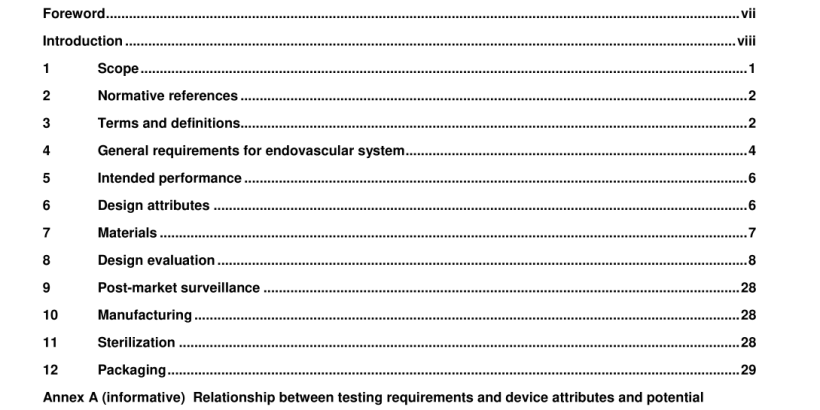ANSI AAMI ISO 25539-1-2017 pdf download
ANSI AAMI ISO 25539-1-2017 pdf download.Cardiovascular implants—Endovascular devices
1 Scope
This document specifies requirements for the evaluation of endovascular systems (prostheses and delivery systems) and requirements with respect to nomenclature, design attributes and information supplied by the manufacturer based upon current medical knowledge. Guidance for the development of in vitro test methods is included in an informative annex to this document. This document can be considered as a supplement to ISO 14630, which specifies general requirements for the performance of non-active surgical implants. This document is applicable to endovascular systems used to treat aneurysms, stenoses or other vascular anomalies or pathologies (e.g. dissections, transections) or to create shunts between vessels [e.g. creation of transjugular intrahepatic portosystemic shunting (TIPS)]. Some of the requirements are specific to endovascular treatment of arterial aneurysms or stenoses. Although uses of endovascular systems other than treatment of arterial aneurysms or stenoses (e.g. dissections, transections, shunts) are within the scope of this document, the specific requirements and testing are not described. Similarly, specific prosthesis configurations (e.g. fenestrated, branched) are within the scope, but specific requirements and testing are not described for these devices. This document is not applicable to vascular occluders, with the exception of contra-lateral iliac artery occluders when used as an integral part of aorto-uni-iliac endovascular prosthesis. Although contra-lateral iliac artery occluders when used as an integral part of aorto-uni-iliac endovascular prosthesis are within the scope of this document, specific requirements and testing are not described for these devices.
Balloons used to achieve adequate apposition of the prosthesis with the vessel wall or overlapping components are within the scope of this document, even if they are not integral to the endovascular system. This document provides requirements beyond the requirements of ISO 1 0555-4, specific to the use of balloons with endovascular prostheses. This document is not applicable to procedures and devices used prior to the introduction of the endovascular system, such as balloon angioplasty devices. The valve component of valved conduits constructed with an endovascular prosthesis component and the combination of the valved component and the endovascular prosthesis component are excluded from the scope of this document. This document can be helpful in identifying the appropriate evaluation of the endovascular prosthesis component of a valved conduit, but specific requirements and testing are not described for these devices. NOTE 1 Cardiac valved conduits are within the scope of ISO 5840-1 . Pharmacological aspects of drug eluting or drug coated endovascular prostheses are not addressed in this document. NOTE 2 Vascular device-drug combination products are within the scope of ISO 1 241 7. This document does not address the requirements for, and the evaluation of, viable tissues and non-viable biologic materials used in the construction of endovascular prostheses. The requirements for, and the evaluation of, degradation and other time-dependant aspects of absorbable materials used in the construction of endovascular prostheses are not addressed in this document. NOTE 3 Absorbable materials are within the scope of ISO/TS 1 71 37 and ISO/TR 371 37.
A device evaluation strategy (DES) shall be created. A DES provides the rationale for the testing selected to evaluate the endovascular system based on the requirements of the device design and potential failure modes. DES may be communicated in a table (DES table) with column headings as presented and explained in Table A.1 . Tables A.3 and A.4 may serve as the foundation for DES applicable to specific endovascular prosthesis and would be expanded upon as appropriate to address the unique aspects of the device. Alternative methods for presenting DES may be used (e.g. a non-tabular presentation of the rationale for the testing based on the potential risks and benefits of the endovascular system for the intended clinical use). Emerging-technology endovascular systems should be evaluated following the basic requirements of this document. The device evaluation strategy should identify any testing needed beyond the scope of this document to characterize these endovascular systems. NOTE 1 All testing might not be appropriate for all endovascular system designs or intended clinical uses. Whenever changes are made in materials, construction, configuration, intended clinical use or processing methods, an appropriate analysis of the potential impact of the change on the potential failure modes and performance of the endovascular system shall be performed. The device evaluation strategy may be outlined in a table with column headings as presented in Table A.5. Appropriate testing shall be conducted as deemed necessary, considering the potential failure modes associated with the change. The use of a control device for comparison may be considered in the evaluation of certain design attributes, particularly for design iterations.
